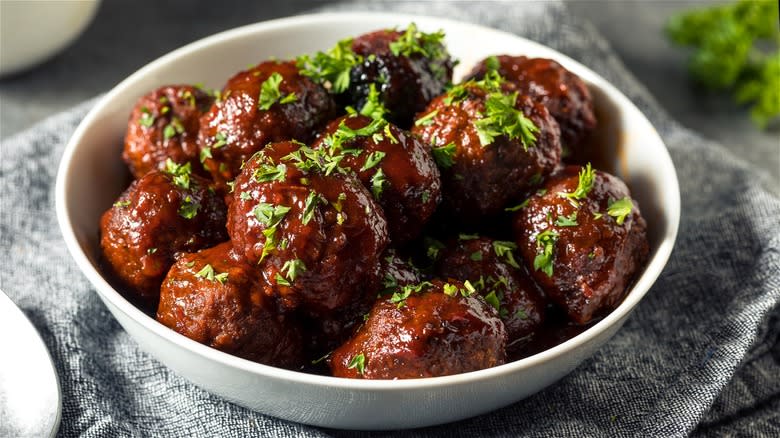Why Milk Is Such An Important Ingredient When Making Meatballs

If you need some flexibility around mealtime, you may want to consider meatball recipes. Meatballs are one of those foods that can be catered to what you have on hand, yet each variety follows a similar base of ingredients. Ground meat is mixed with herbs and spices followed, by a liquid for added moisture. Egg is used as a binding agent, and some type of bread crumb or cracker is added to give meatballs a bit more depth. When it comes to adding liquid to meatball mixtures, milk is often used for its versatility, depth of flavor, and richness. Without the use of milk, you may be faced with a plate of dry meatballs.
Milk adds a certain level of moisture that helps produce perfectly tender meatballs. Whether you add a splash or two or use a specific amount to make a panade, which is most commonly seen as a blend of mashed breadcrumbs and milk, this resourceful dairy product is key to crafting a plate of perfectly soft and evenly cooked meatballs. But why has milk become the recommended liquid of choice for traditional meatball recipes?
Read more: 15 Tips For Making The Best Meatloaf
Milk Provides More Than Moisture

It's easy to see why liquid is such an important ingredient for perfect meatballs. While you might assume milk's only role in these hearty snacks is to keep the meat nice and moist, this creamy, protein-rich liquid provides another benefit. Among the many tips every home chef should follow when attempting homemade meatballs, using ground meat with a ratio of 80% meat and 20% fat is recommended. Not only does added fat provide loads of immeasurable flavor, but meatballs made with a little extra fat are also sure to stay nice and moist throughout the cooking process.
Even if you don't shy away from ground meat that contains a higher percentage of fat, whole milk's luscious consistency adds richness to any meatball recipe. Home chefs who enjoy using lean ground chicken or turkey can rely on eggs and dairy to replace the missing fat component in this versatile dish.
Although milk may seem like the most important component in crafting delicious meatballs, a crucial step in the meatball-making process is using a panade made of milk and bread crumbs to keep the meatballs perfectly tender. This mush-like mixture is gently mixed into the meat before being rolled into balls. And if you happen to be fresh out of milk, you can make a satisfactory panade with other useful ingredients besides whole milk.
Make Delicious Meatballs With One Of Many Sufficient Milk Alternatives

If you only have high-fat options, such as sour cream, heavy cream, and buttermilk, you can use one of these ingredients as an effective milk alternative. However, you may need to add a bit of water or broth to thin out the consistency of any thicker substitutes before making an effective panade.
And if you're looking to make dairy-free meatballs, you can either add plant-based milk or turn to the rich ingredient you should use for baked meatballs: beef broth. Rich and flavorful broth adds both moisture and an extra boost of flavor. If you have none on hand, you can still make tender meatballs with water, bread crumbs, and an egg. Just make sure you use enough water and seasoning to keep the meat moist and flavorful.
If you happen to try one of these resourceful milk alternatives, using the recommended meat-to-fat ratio is even more crucial. Because traditional milk provides both moisture and fat, using meat with a higher ratio of fat will make up for any potential loss in a dairy-free substitute. There are many avenues that lead to delicious and tender meatballs. While water and broth may keep the meatballs moist throughout the cooking process, milk's extra fat and luscious consistency add an unmatched level of complexity to any classic meatball recipe.
Read the original article on Daily Meal.

